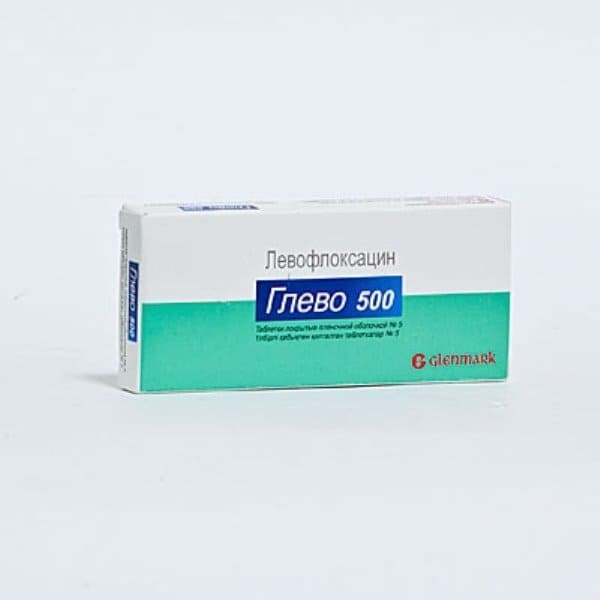You have no items in your shopping cart.

Sku:
Dosage form
Tablets, film-coated
Composition
levofloxacin (hemihydrate) \0009500 mg
Excipients: cellulose microcrystalline, povidone (K-30), crospovidone, magnesium stearate, cellulose microcrystalline (avicel рН101).
The film composition of the shell: hypromellose, macrogol (polyethylene glycol 6000), dibutyl phthalate, talc, titanium dioxide, colouring agent iron oxide red, dye iron oxide yellow.
Pharmacological action
antibacterial agent of the fluoroquinolone broad spectrum. Levofloxacin does DNK-girazu (topoisomerase II) and topoisomerase IV, violates supercoiling and cross-linking of DNA breaks, inhibits DNA synthesis, causes profound morphological changes in cytoplasm, cell walls and membranes of microorganisms.
The drug is active against aerobic gram-positive microorganisms: Corynebacterium diphtheriae, Enterococcus spp. (including Enterococcus faecalis), Listeria monocytogenes, Staphylococcus spp. (coagulase-negative, including methicillin-sensitive/methicillin-resistant-moderately susceptible strains), Staphylococcus aureus (methicillin-susceptible strains), Staphylococcus epidermidis (methicillin-susceptible strains), Streptococcus spp. groups C and G, Streptococcus agalactiae, Streptococcus pneumoniae (penicillin-sensitive/moderately sensitive/resistant strains), Streptococcus pyogenes, Streptococcus viridans (penicillin is moderately sensitive/resistant strains); aerobic gram-negative microorganisms: Acinetobacter spp. (including Acinetobacter baumannii), Actinobacillus actinomycetemcomitans, Citrobacter freundii, Eikenella corrodens, Enterobacter spp. (incl. Enterobacter aerogenes, Enterobacter agglomerans, Enterobacter cloacae), Escherichia coli, Gardnerella vaginalis, Haemophilus ducreyi, Haemophilus influenzae (ampicillin-sensitive/resistant strains), Haemophilus parainfluenzae, Helicobacter pylori, Klebsiella spp. (including Klebsiella oxytoca, Klebsiella pneumoniae), Moraxella catarrhalis (producing and reproducirse ?-lactamase), Morganella morganii, Neisseria gonorrhoeae (and reproducirse producing penicillinase), Neisseria meningitidis, Pasteurella spp. (incl. Conis Pasteurella, Pasteurella dagmatis, Pasteurella multocida) Proteus mirabilis, Proteus vulgaris, Providencia spp. (including Providencia rettgeri, Providencia stuartii), Pseudomonas spp. (including Pseudomonas aeruginosa), Salmonella spp., Serratia spp. (including Serratia marcescens); anaerobic microorganisms: Bacteroides fragilis, Bifidobacterium spp., Clostridium perfringens, Fusobacterium spp., Peptostreptococcus spp., Propionibacterium spp., Veilonella spp.; other microorganisms: Bartonella spp. Chlamydia pneumoniae, Chlamydia psittaci, Chlamydia trachomatis, Legionella pneumophila, Legionella spp., Mycobacterium spp. (including Mycobacterium leprae, Mycobacterium tuberculosis), Mycoplasma hominis, Mycoplasma pneumoniae, Rickettsia spp. Ureaplasma urealyticum.
Testimony
Infectious-inflammatory diseases caused by sensitive microorganisms:
— infections of ENT organs (including acute sinusitis);
— infections of the lower respiratory tract (including exacerbation of chronic bronchitis, community-acquired pneumonia);
— uncomplicated and complicated urinary tract infections and kidney (including acute pyelonephritis, prostatitis);
infection of the genitals;
— infections of skin and soft tissues (festering atheroma, abscess, furunkoulez);
infection of the abdominal cavity (in combination with drugs acting on the anaerobic microflora).
Contraindications
— epilepsy;
— the defeat tendons at the earlier treatment quinolones;
— pregnancy;
— lactation (breastfeeding);
— children's and teenage age (till 18 years);
— hypersensitivity to levofloxacin and other fluoroquinolones.
With caution should designate product in elderly patients (due to high probability of having a concomitant loss of kidney function), the deficit glukozo-6-fosfatdegidrogenaza.
Drug interactions
While the use of levofloxacin increases the T1/2 of cyclosporine.
The effect of the drug reduce drugs that inhibit intestinal motility, sucralfate, aluminum/magnesium antacid medicines and iron salts (needed to break between the reception of at least 2 hours).
With simultaneous use of NSAIDs with Glevo, theophylline increased convulsive readiness.
While the use of Glevo corticosteroids increases the risk of tendon rupture.
Cimetidine and drugs that block tubular secretion, slow down the excretion of levofloxacin.
With simultaneous use of hypoglycemic drugs with levofloxacin may develop Hypo - and hyperglycemia. Therefore, it is necessary to strictly control glucose levels in the blood.